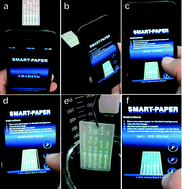Smartphone quantifies Salmonella from paper microfluidics†
Abstract
Smartphone-based optical detection is a potentially easy-to-use, handheld, true point-of-care diagnostic tool for the early and rapid detection of pathogens. Paper microfluidics is a low-cost, field-deployable, and easy-to-use alternative to conventional microfluidic devices. Most paper-based microfluidic assays typically utilize dyes or enzyme–substrate binding, while bacterial detection on paper microfluidics is rare. We demonstrate a novel application of smartphone-based detection of Salmonella on paper microfluidics. Each paper microfluidic channel was pre-loaded with anti-Salmonella Typhimurium and anti-Escherichia coli conjugated submicroparticles. Dipping the paper microfluidic device into the Salmonella solutions led to the antibody-conjugated particles that were still confined within the paper fibers to immunoagglutinate. The extent of immunoagglutination was quantified by evaluating Mie scattering from the digital images taken at an optimized angle and distance with a smartphone. A smartphone application was designed and programmed to allow the user to position the smartphone at an optimized angle and distance from the paper microfluidic device, and a simple image processing algorithm was implemented to calculate and display the bacterial concentration on the smartphone. The detection limit was single-cell-level and the total assay time was less than one minute.


 Please wait while we load your content...
Please wait while we load your content...